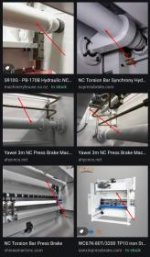Hi,
We have a small prototype shop and we want to have our own press brake and not always have to rely on external sources. Especially now when we plane to "mass" produce a sheet metal box.
We are located in Vietnam so it is fairly convenient for us to buy direct from China and get it over here by truck. We have looked at a few machines online. It looks like we are going for a "torsion-synchronized" 40T2500mm with 3 servo axes on Y+X+R and a TP10S control panel, for about $10,000 shipped over here.
We mostly need to bend small sheets but we plan to make some large stainless (1mm) workbenches, 2400mm long. The small items we have are 3mm 5052-36 aluminum not longer than 1200mm, but mostly only 100-300mm wide. and a few shorter 300mm 6mm aluminum.
This is my first press brake and looking for some advice:
All suggestions are highly appreciated. Thanks
We have a small prototype shop and we want to have our own press brake and not always have to rely on external sources. Especially now when we plane to "mass" produce a sheet metal box.
We are located in Vietnam so it is fairly convenient for us to buy direct from China and get it over here by truck. We have looked at a few machines online. It looks like we are going for a "torsion-synchronized" 40T2500mm with 3 servo axes on Y+X+R and a TP10S control panel, for about $10,000 shipped over here.
We mostly need to bend small sheets but we plan to make some large stainless (1mm) workbenches, 2400mm long. The small items we have are 3mm 5052-36 aluminum not longer than 1200mm, but mostly only 100-300mm wide. and a few shorter 300mm 6mm aluminum.
This is my first press brake and looking for some advice:
- What should we pay attention to?
- What are the parts that they may cheap out on? It weighs 3200 kilo, is that enough?
- Does one need crowning on such small machine?
- Does such small machine need "electro-hydraulic-syncronisation" on Y1+Y2? It adds like $10,000 on to the price.
- Im getting fast release clamps, segmented goose neck dies punches and dies, linear ball guides in fingers and front support as "free" extras. What else "extras" would one need than more punches and dies??
- Most parts claims to be European/US branded ones.
All suggestions are highly appreciated. Thanks


